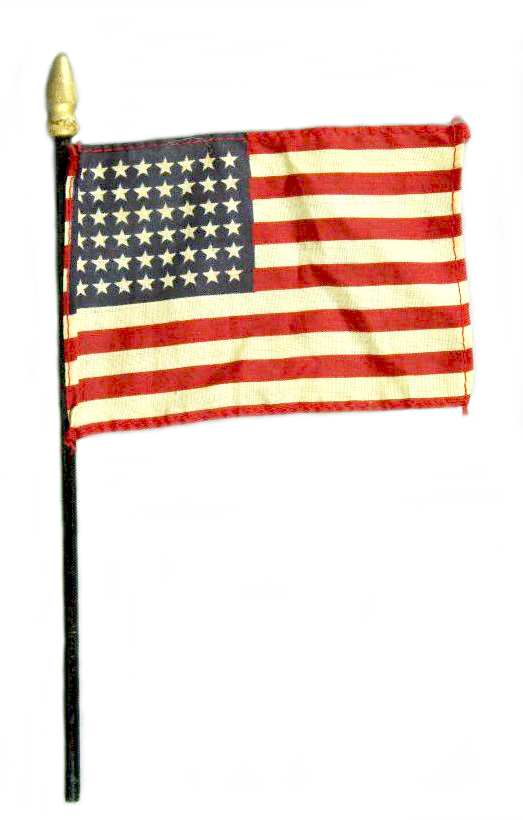Way Back Wednesday: History of the American Flag
Tags: History CollectionUnited States Flag, 48 stars, 1958, Collection of The Grace Museum, Gift of Mrs. Martha Pender
(SOURCE)
On June 14, 1777, the Continental Congress passed an act establishing an official flag for the new nation. The resolution stated: “Resolved, that the flag of the United States be thirteen stripes, alternate red and white; that the union be thirteen stars, white in a blue field, representing a new constellation.” On Aug. 3, 1949, President Harry S. Truman officially declared June 14 as Flag Day.
The history of our flag is as fascinating as that of the American Republic itself. It has survived battles, inspired songs and evolved in response to the growth of the country it represents. The following is a collection of interesting facts and customs about the American flag and how it is to be displayed:
ORIGINS
Old Glory Photo Credit: Hugh Talman / NMAH, SI
The origin of the first American flag is unknown. Some historians believe it was designed by New Jersey Congressman Francis Hopkinson and sewn by Philadelphia seamstress Betsy Ross.
The name Old Glory was given to a large, 10-by-17-foot flag by its owner, William Driver, a sea captain from Massachusetts. Inspiring the common nickname for all American flags, Driver’s flag is said to have survived multiple attempts to deface it during the Civil War. Driver was able to fly the flag over the Tennessee Statehouse once the war ended. The flag is a primary artifact at the National Museum of American History and was last displayed in Tennessee by permission of the Smithsonian at an exhibition in 2006.
Between 1777 and 1960 Congress passed several acts that changed the shape, design and arrangement of the flag and allowed stars and stripes to be added to reflect the admission of each new state.
Today the flag consists of 13 horizontal stripes, seven red alternating with six white. The stripes represent the original 13 Colonies and the stars represent the 50 states of the Union. The colors of the flag are symbolic as well; red symbolizes hardiness and valor, white symbolizes purity and innocence, and blue represents vigilance, perseverance and justice.
The National Museum of American History has undertaken a long-term preservation project of the enormous 1814 garrison flag that survived the 25-hour shelling of Fort McHenry in Baltimore by British troops and inspired Francis Scott Key to compose “The Star-Spangled Banner.” Often referred to by that name, the flag had become soiled and weakened over time and was removed from the museum in December 1998. This preservation effort began in earnest in June 1999, and continues to this day. The flag is now stored at a 10-degree angle in a special low-oxygen, filtered light chamber and is periodically examined at a microscopic level to detect signs of decay or damage within its individual fibers.
There are a few locations where the U.S. flag is flown 24 hours a day, by either presidential proclamation or by law:
-
Fort McHenry, National Monument and Historic Shrine, Baltimore, Maryland
-
Flag House Square, Baltimore, Maryland
-
United States Marine Corps Memorial (Iwo Jima), Arlington, Virginia
-
On the Green of the Town of Lexington, Massachusetts
-
The White House, Washington, D.C.
-
United States customs ports of entry
-
Grounds of the National Memorial Arch in Valley Forge State Park, Valley Forge, Pennsylvania
INSPIRATION
After a British bombardment, amateur poet Francis Scott Key was so inspired by the sight of the American flag still flying over Baltimore’s Fort McHenry that he wrote “The Star-Spangled Banner” on Sept. 14, 1814. It officially became our national anthem in 1931.
In 1892, the flag inspired James B. Upham and Francis Bellamy to write The Pledge of Allegiance. It was first published in a magazine called The Youth’s Companion.
ON DISTANT SHORES
In 1909, Robert Peary placed an American flag, sewn by his wife, at the North Pole. He also left pieces of another flag along the way. It is the only time a person has been honored for cutting the flag.
In 1963, Barry Bishop placed the American flag on top of Mount Everest.
In July 1969, the American flag was “flown” in space when Neil Armstrong placed it on the moon. Flags were placed on the lunar surface on each of six manned landings during the Apollo program.
The first time the American flag was flown overseas on a foreign fort was in Libya, over Fort Derne, on the shores of Tripoli in 1805.
NASA Photo Credit: Courtesy of nasa.gov
Displaying the Stars and Stripes
The flag is usually displayed from sunrise to sunset. It should be raised briskly and lowered ceremoniously. In inclement weather, the flag should not be flown.
The flag should be displayed daily and on all holidays, weather permitting, on or near the main administration buildings of all public institutions. It should also be displayed in or near every polling place on election days and in or near every schoolhouse during school days.
When displayed flat against a wall or a window, or in a vertical orientation, the “union” field of stars should be uppermost and to the left of the observer.
When the flag is raised or lowered as part of a ceremony, and as it passes by in parade or review, everyone, except those in uniform, should face the flag with the right hand over the heart.
The U.S. flag should never be dipped toward any person or object, nor should the flag ever touch anything beneath it.


